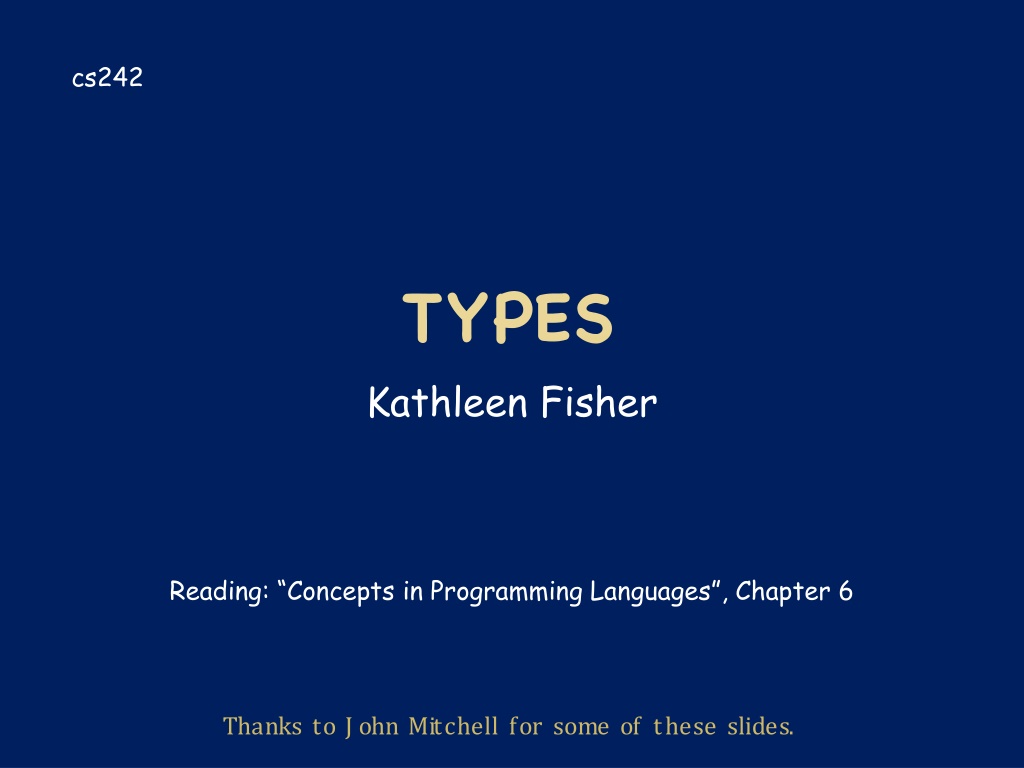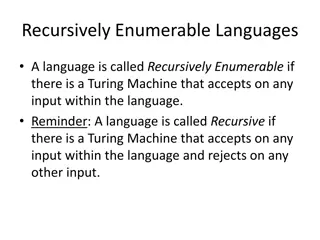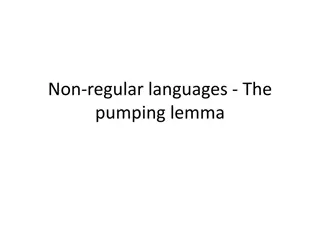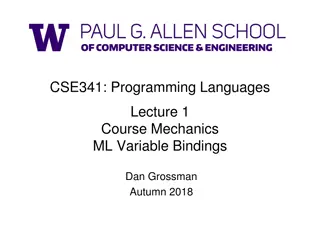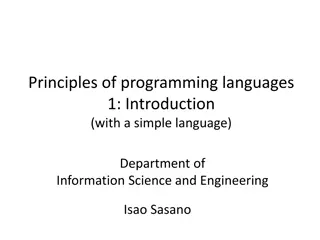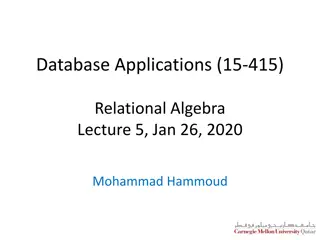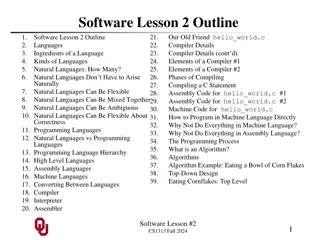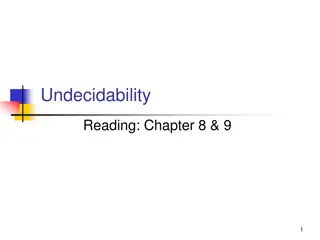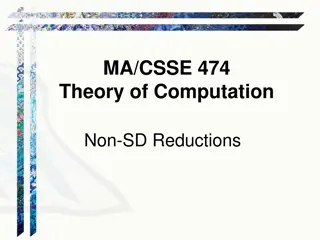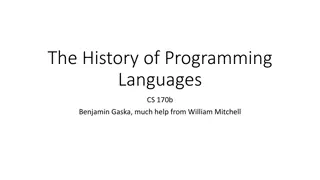Understanding Types in Programming Languages
Types in programming languages play a crucial role in organizing, documenting, and preventing errors in code. They define collections of computable values with shared structural properties and help in program analysis, optimization, and error detection. This content covers the concepts of types, their uses, compile-time vs. run-time checking, polymorphism, and language design trade-offs. It also discusses the goals of programming languages and the importance of type inference in static analysis.
Download Presentation

Please find below an Image/Link to download the presentation.
The content on the website is provided AS IS for your information and personal use only. It may not be sold, licensed, or shared on other websites without obtaining consent from the author. Download presentation by click this link. If you encounter any issues during the download, it is possible that the publisher has removed the file from their server.
E N D
Presentation Transcript
cs242 TYPES Kathleen Fisher Reading: Concepts in Programming Languages , Chapter 6 Thanks to J ohn Mitchell for some of these slides.
Announcement We are looking for homework graders. If you are interested, send mail to cs242@cs.stanford.edu Need to be available approximately 5-9pm on Thursdays. You ll be paid Stanford s hourly rate. We ll provide food of your choice. Previous graders have really enjoyed it. Great way to really learn the material.
Outline General discussion of types What is a type? Compile-time vs run-time checking Conservative program analysis Type inference Will study algorithm and examples Good example of static analysis algorithm Polymorphism Uniform vs non-uniform impl of polymorphism Polymorphism vs overloading
Language Goals and Trade-offs Thoughts to keep in mind What features are convenient for programmer? What other features do they prevent? What are design tradeoffs? Easy to write but harder to read? Easy to write but poorer error messages? What are the implementation costs? Architect Programmer Programming Language Compiler, Runtime environ- ment Tester Diagnostic Tools
Type A type is a collection of computable values that share some structural property. Examples Integer String Int (Int Non-examples 3, True, \x->x Even integers f:Int then f(x) > x *(x+1) Bool Int) Int | if x>3 Bool Distinction between sets that are types and sets that are not types is language dependent.
Uses for Types Program organization and documentation Separate types for separate concepts Represent concepts from problem domain Indicate intended use of declared identifiers Types can be checked, unlike program comments Identify and prevent errors Compile-time or run-time checking can prevent meaningless computations such as 3 + true Bill Support optimization Example: short integers require fewer bits Access record component by known offset
Compile-time vs Run-time Checking JavaScript and Lisp use run-time type checking f(x) Make sure f is a function before calling f. ML and Haskell use compile-time type checking f(x) Must have f : A B and x : A Basic tradeoff Both kinds of checking prevent type errors. Run-time checking slows down execution. Compile-time checking restricts program flexibility. JavaScript array: elements can have different types Haskell list: all elements must have same type Which gives better programmer diagnostics?
Expressiveness In JavaScript, we can write a function like function f(x) { return x < 10 ? x : x(); } Some uses will produce type error, some will not. Static typing always conservative if (big-hairy-boolean-expression) then f(5); else f(15); Cannot decide at compile time if run-time error will occur!
Relative Type-Safety of Languages Not safe: BCPL family, including C and C++ Casts, pointer arithmetic Almost safe: Algol family, Pascal, Ada. Dangling pointers. Allocate a pointer p to an integer, deallocate the memory referenced by p, then later use the value pointed to by p. No language with explicit deallocation of memory is fully type-safe. Safe: Lisp, Smalltalk, ML, Haskell, Java, JavaScript Dynamically typed: Lisp, Smalltalk, JavaScript Statically typed: ML, Haskell, Java
Type Checking vs.Type Inference Standard type checking: int f(int x) { return x+1; }; int g(int y) { return f(y+1)*2; }; Examine body of each function. Use declared types to check agreement. Type inference: int f(int x) { return x+1; }; int g(int y) { return f(y+1)*2;}; Examine code without type information. Infer the most general types that could have been declared. ML and Haskell are designed to make type inference feasible.
Why study type inference? Types and type checking Improved steadily since Algol 60 Eliminated sources of unsoundness. Become substantially more expressive. Important for modularity, reliability and compilation Type inference Reduces syntactic overhead of expressive types Guaranteed to produce most general type. Widely regarded as important language innovation Illustrative example of a flow-insensitive static analysis algorithm
History Original type inference algorithm was invented by Haskell Curry and Robert Feys for the simply typed lambda calculus in 1958. In 1969, Hindley extended the algorithm to a richer language and proved it always produced the most general type. In 1978, Milner independently developed equivalent algorithm, called algorithm W, during his work designing ML. In 1982, Damas proved the algorithm was complete. Already used in many languages: ML, Ada, Haskell, C# 3.0, F#, Visual Basic .Net 9.0, and soon in: Fortress, Perl 6, C++0x We ll use ML to explain the algorithm because it is the original language to use the feature and is the simplest place to start.
ML Type Inference Example - fun f(x) = 2 + x; > val it = fn : int What is the type of f? + has two types: int real 2has only one type: int This implies + : int From context, we need x:int Therefore f(x) = 2+x has type int int int, int real real int int int
Systematic Presentation Example -fun f(x) = 2+x; >val it = fn:int What is the type of f? Assign types to leaves Graph for \x->((plus 2) x) int t int = int int int (t = int) @ int int Propagate to internal nodes and generate constraints x @ : t + 2 : int int int int real real real Solve by substitution
Application : r (s = domain range) (domain = d) (range = r) @ : s : d f x Apply function f to argument x: f(x) Because f is being applied, its type (s in figure) must be a function type: domain range. Domain of f must be type of argument x (d in figure). Range of f must be result type of expression (r in figure). Solving, we get: s = d r.
Abstraction (s = domain range) (domain = d) (range = r) : s : r : d e x Function expression: \x -> e Type of lambda abstraction (s in figure) must be a function type: domain range. Domain is type of abstracted variable x (d in figure). Range is type of function body e (r in figure). Solving, we get : s = d r.
Types with Type Variables Example -fun f(g) = g(2); >val it = fn : (int What is the type of f? t) t Graph for \g (g 2) Assign types to leaves s t = (int t) t Propagate to internal nodes and generate constraints t (s = int t) @ g : s 2 Solve by substitution : int
Use of Polymorphic Function Function -fun f(g) = g(2); >val it = fn:(int Possible applications t) t -fun add(x) = 2+x; >val it = fn:int -f(add); >val it = 4 : int -fun isEven(x) = ...; >val it = fn:int -f(isEven); >val it = true : bool int bool
Recognizing Type Errors Function -fun f(g) = g(2); >val it = fn:(int t) t Incorrect use -fun not(x) = if x then false else true; >val it = fn : bool -f(not); Error: operator and operand don't agree operator domain: int -> 'Z operand: bool -> bool Type error: cannot make bool bool = int t bool
Another Type Inference Example Function Definition -fun f(g,x) = g(g(x)); >val it = fn:(t Type Inference t)*t t Graph for g,x . g(g x) s*t v = (v v)*v v Assign types to leaves v (s = u v) @ Propagate to internal nodes and generate constraints : s g u (s = t u) @ g : s : t x Solve by substitution
Polymorphic Datatypes Datatype with type variable - datatype a list = nil | cons of a *( a list) > nil : a list > cons : a *( a list) a list a is syntax for type variable a Polymorphic function - fun length nil = 0 | length (cons(x,rest)) = 1 + length(rest) > length : a list int Type inference Infer separate type for each clause Combine by making two types equal (if necessary)
Type Inference with Recursion length(cons(x,rest)) = 1 + length(rest) : p (p = v w, p = t) ( a* a list a list = s * u v) : w (int int = r w) @ @ : v @ : r (t = u r) @ : s * u : int int cons : a * a list a list : u + 1 : int rest length : t x : s
Type Inference with Recursion length(cons(x,rest)) = 1 + length(rest) Collected Constraints: : p p = t p = v w int int = r w t = u r a* a list a list = s * u v : w @ @ : v @ : r @ : s * u : int int cons : a * a list a list : u + 1 : int rest length : t x : s
Type Inference with Recursion length(cons(x,rest)) = 1 + length(rest) Collected Constraints: : p p = t p = v w int int = r w t = u r a = s a list = u a list = v : w @ @ : v @ : r @ : s * u : int int cons : a * a list a list : u + 1 : int rest length : t x : s
Type Inference with Recursion length(cons(x,rest)) = 1 + length(rest) Collected Constraints: : p p = t p = a list w int int = r w t = a list r : w @ @ : v @ : r @ : s * u : int int cons : a * a list a list : u + 1 : int rest length : t x : s
Type Inference with Recursion length(cons(x,rest)) = 1 + length(rest) Collected Constraints: : p p = t p = a list int t = a list int : w @ @ : v @ : r @ : s * u : int int cons : a * a list a list : u + 1 : int rest length : t x Result: : s p = a list int
Multiple Clauses Function with multiple clauses - fun append(nil,l) = l | append(x::xs,l) = x :: append(xs,l) > append: a list * a list Infer type of each branch First branch: : a list * b b First branch: : a list * b a list Combine by equating types of two branches: append : a list * a list int append append a list
Most General Type Type inference is guaranteed to produce the most general type: - fun map(f,nil) = nil | map(f, x::xs) = f(x) :: (map(f,xs)) > map:('a 'b) * 'a list Function has many other, less general types: map:('a int) * 'a list map:(bool 'b) * bool list map:(char int) * char list Less general types are all instances of most general type, also called the principal type. 'b list int list 'b list int list
Type Inference Algorithm When the Hindley/Milner type inference algorithm was developed, its complexity was unknown. In 1989, Mairson proved that the problem was exponential-time complete. Tractable in practice though
Information from Type Inference Consider this function fun reverse (nil) = nil | reverse (x::xs) = reverse(xs); and its most general type: reverse : a list What does this type mean? Reversing a list does not change its type, so there must be an error in the definition of reverse! b list See Koenig paper on Reading page of CS242 site
Type Inference: Key Points Type inference computes the types of expressions Does not require type declarations for variables Finds the most general type by solving constraints Leads to polymorphism Sometimes better error detection than type checking Type may indicate a programming error even if no type error. Some costs More difficult to identify program line that causes error ML requires different syntax for integer 3, real 3.0. Natural implementation requires uniform representation sizes. Complications regarding assignment took years to work out. Idea can be applied to other program properties Discover properties of program using same kind of analysis
Haskell Type Inference Haskell also uses Hindley Milner type inference. Haskell uses type classes to support user-defined overloading, so the inference algorithm is more complicated. ML restricts the language to ensure that no annotations are required, ever. Haskell provides various features like polymorphic recursion for which types cannot be inferred and so the user must provide annotations.
Parametric Polymorphism: ML vs C++ ML polymorphic function Declarations require no type information. Type inference uses type variables to type expressions. Type inference substitutes for variables as needed to instantiate polymorphic code. C++ function template Programmer must declare the argument and result types of functions. Programmers must use explicit type parameters to express polymorphism. Function application: type checker does instantiation. ML also has module system with explicit type parameters
Example: Swap Two Values ML - fun swap(x,y) = let val z = !x in x := !y; y := z end; val swap = fn : 'a ref * 'a ref -> unit C++ template <typename T> void swap(T& x, T& y){ T tmp = x; x=y; y=tmp; } Declarations look similar, but compiled very differently
Implementation ML Swap is compiled into one function Typechecker determines how function can be used C++ Swap is compiled into linkable format Linker duplicates code for each type of use Why the difference? ML ref cell is passed by pointer. The local x is a pointer to value on heap, so its size is constant. C++ arguments passed by reference (pointer), but local x is on the stack, so its size depends on the type.
Another Example C++ polymorphic sort function template <typename T> void sort( int count, T * A[count ] ) { for (int i=0; i<count-1; i++) for (int j=i+1; j<count-1; j++) if (A[j] < A[i]) swap(A[i],A[j]); } What parts of code depend on the type? Indexing into array Meaning and implementation of <
Polymorphism vs Overloading Parametric polymorphism Single algorithm may be given many types Type variable may be replaced by any type iff:t t then f:int Overloading A single symbol may refer to more than one algorithm Each algorithm may have different type Choice of algorithm determined by type context Types of symbol may be arbitrarily different + has types int*int int, real*real others int,f:bool bool, ... real, no
Summary Types are important in modern languages Program organization and documentation Prevent program errors Provide important information to compiler Type inference Determine best type for an expression, based on known information about symbols in the expression Polymorphism Single algorithm (function) can have many types Overloading One symbol with multiple meanings, resolved at compile time
